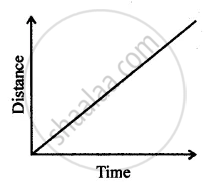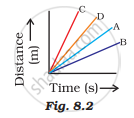Advertisements
Advertisements
प्रश्न
A car travels a distance 100 m with constant acceleration and average velocity of 20 ms-1. The final velocity acquired by the car is 25 ms-1.
Find
(i) The initial velocity.
(ii) Acceleration of the car.
उत्तर
Distance travelled s = 100 m
Average velocity V = 20 m/s
Final velocity v = 25 m/s
(i) Let u be the initial velocity.
Average velocity = (Initial velocity + Final velocity)/2
V = (u + v)/2
20 = (u + 25)/2
u = 40 - 25 = 15 m/s-1
(ii) Let 'a' be the acceleration of the car.
Using the third equation of motion,
v2 - u2 = 2as
We get,
(25) 2 - (15) 2 = 2 (a) (100)
625 - 225 = 200 a
a = (400/200) m/s2 = 2 m/s-2
APPEARS IN
संबंधित प्रश्न
A body is moving along a circular path of radius R. What will be the distance travelled and displacement of the body when it completes half a revolution ?
Define displacement. State its unit.
From the displacement-time graph of a cyclist given below in the Figure, find The displacement from the initial position at the end of 10 s,

Give an example of a body which covers a certain distance, but its displacement is zero.
Can you suggest the kind of motion of a body from the following distance – time graph?

An object covers a distance of S meters in t seconds as follows :
| S (meters) | 0 | 8 | 20 | 20 | 16 | 10 | 0 |
| t (Seconds) | 80 | 2 | 5 | 10 | 12 | 15 | 10 |
Plot a graph, taking t on X-axis and S on Y-axis. Determine the velocity of the object at time
(i) 6 s, and
(ii) 14 s.
Distinguish distance and displacement.
Four cars A, B, C, and D are moving on a levelled road. Their distance versus time graphs are shown in Fig. 8.2. Choose the correct statement.

An object is dropped from rest at a height of 150 m and simultaneously another object is dropped from rest at a height of 100 m. What is the difference in their heights after 2s if both the objects drop with the same accelerations? How does the difference in heights vary with time?
A particle is moving in a circular pattern of radius r. The displacement after half a circle would be ______.
